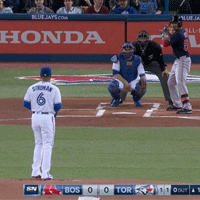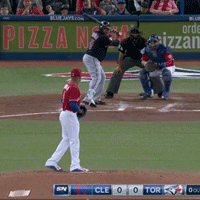What Marcus Stroman May Have Learned from David Price
Marcus Stroman ended June with a bloated 5.33 ERA that was mostly deserved, so he went back to the drawing board. He’s since had an ERA two runs lower, once again deserved, since he changed things in early July.
After a good start in early July, he made general reference to some adjustments after the game, and Shi Davidi went and asked pitching coach Pete Walker for some specifics. So we know some of what Stroman did to recover. He cleaned up the delivery, he moved his hands, he changed his release point, and he altered his pitching mix. It’s the kind of stuff pitchers do to bust a slump.
The most interesting thing might be where he learned these things, though. Who knows when he picked them up from the Red Sox lefty, but these adjustments have made Stroman a bit more like David Price these days. Even if Price is struggling a bit, you have to count that as a good thing compared to where Stroman was earlier this season.
First, the easy thing. By line drives and home runs, Stroman’s curve and change are his worst pitches. They do decently by whiffs, but balls in play had been part of the righty’s problems early on, to which his bloated .322 batting average on balls in play attests. So Stroman started throwing those pitches less, and his better pitches more.
| Date | FB% | SL% | CT% | CB% | CH% |
| April-June | 59% | 11% | 11% | 11% | 8% |
| July-August | 59% | 23% | 7% | 7% | 4% |
Simple enough. But that doesn’t capture the fact that his pitches changed a bit. His slider and change gained some dropand horizontal movement, his curve began to feature more horizontal movement, and his four-seam more velocity. Things changed in other ways.
Over at Blue Jay Hunter, Ian Hunter spotted some of the small changes Stroman made to his delivery that line up well with what Stroman’s coach said to Davidi. “With his height, he has to do everything he can to stay on top of the baseball,” said Walker. “By lowering his hands a little bit, simplifying the delivery, minimizing his head movement, getting his hands out on time definitely makes a difference.” Hunter illustrates those differences well, including this particular image here:
That’s a big difference in hands, and it links up exactly with what his pitching coach was pointing out. That, and some of the simplification in movement, are a big part of the story. Looking at his spin rates, you can see that his curve and four-seam spin rates have gone up.
| Pitch | Spin Early | Spin Late |
| Change | 1435 | 1450 |
| Curve | 2397 | 2788 |
| Cutter | 2061 | 1510 |
| Four-Seam | 2073 | 2281 |
| Sinker | 2206 | 2229 |
| Slider | 1578 | 1593 |
This looks like evidence that Stroman is staying on top of the ball better. The more over the top you are, the more four-seam spin and ride you get. Stroman isn’t necessarily more over the top with his release point, but the change might also be a product of how he’s holding his hand at release, because hand action also matters.
In any case, within Hunter’s piece he mentions one thing in an offhand matter that gives us Stroman’s role model. “This is a trick Marcus Stroman apparently picked up from David Price; simply stepping backwards on his plant foot to initiate delivery,” Hunter wrote. Let’s put Stroman’s early and late deliveries up against Price’s, then.
It looks like Stroman learned a little simplicity from Price, along with that glove placement. It’s not quite a mirror image, but there’s something there.
When Price came to Toronto, Stroman said that he was excited to learn from the lefty. Maybe he did learn from him. Maybe it just took a while for the lessons to really take hold. In either case, Stroman has been more like Price recently when it comes to results (producing, for example, a strikeout- and walk-rate differential of 23.6 points since July 1, not unlike Price’s 19.8-point mark this year) and also when it comes to process.
When you’re struggling, it helps to look around and learn from the successful. Kudos to Stroman for keeping his eyes open.
With a phone full of pictures of pitchers' fingers, strange beers, and his two toddler sons, Eno Sarris can be found at the ballpark or a brewery most days. Read him here, writing about the A's or Giants at The Athletic, or about beer at October. Follow him on Twitter @enosarris if you can handle the sandwiches and inanity.





How to be a #4 starter?
When did they disable the “upvote” function on these comments?
As a BoSox fan, this is hilarious – well done.